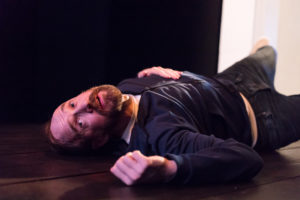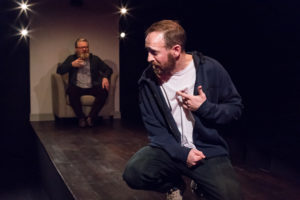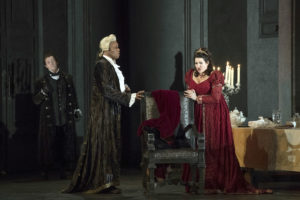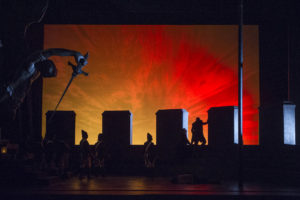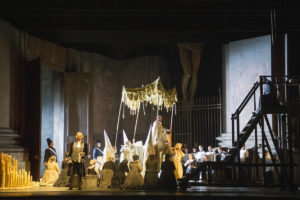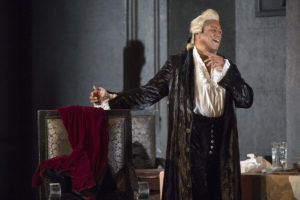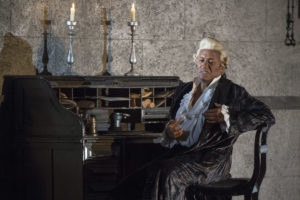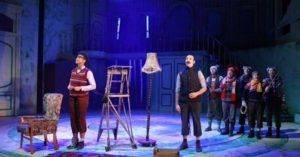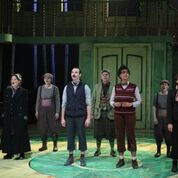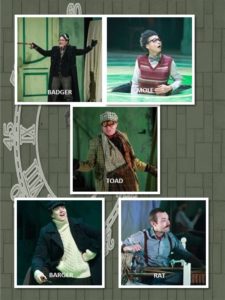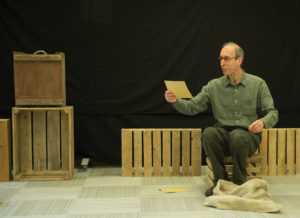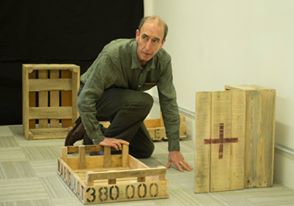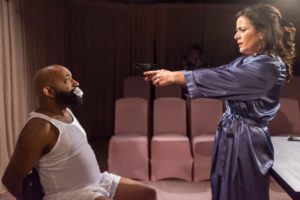
 (3 / 5)
(3 / 5)
Fio’s timely revival of Chilean/American Ariel Dorfman’s seminal 1991 play Death and the Maiden reminds us that its message is still as vital now, as it was nearly thirty years ago.
Cast
Lisa Zahra as Paulina Salas (38 years old)
Vinta Morgan as Geraldo (her husband, a lawyer about forty five years old)
Pradeep Jey as Roberto Miranda ( a doctor, around fifty years old)
Directed by Abdul Shayek
Designer: Amy Jane Cook
Lighting: Ciaran Cunningham
Venue: The Other Room, Cardiff runs to 10th November at 1930 hours. Matinee performance on 4th November at 1500.
http://https://www.ticketsource.co.uk/otherroomtheatre
The plays runs for about 95 minutes without an interval. It features strong language and explicit dialogue of a sexual nature and of torture.
Plot of Death and the Maiden
Paulina Salas is a psychologically damaged early middle-aged woman whose husband Geraldo, has been appointed to a commission to examine human rights abuses during a period of dictatorship that their country has very recently endure. Now with the promise of democracy, the country is trying to adapt to the challenges that the past has endowed upon it.
Paulina was a political prisoner during the turbulent period of totalitarianism and was tortured and repeatedly raped by her captors, led by a doctor who played Schubert’s Death and the Maiden during her most violated experiences.
Geraldo brings home Roberto Miranda who has helped him after his car had sustained a flat tyre. Later, Roberto returns to make arrangements about helping his new friend the following day. Paulina, who was constantly blindfolded when in company of her cruel tormentor, recognises that her husband’s new acquaintance is the same doctor by his voice and phrases he uses.
Geraldo and Robert chat late into the night and it is apparent that a bond of friendship has developed between them. Due to the fact that it is the early hours of the morning when they decide to end their conversation, Geraldo invites Roberto to stay the night. Meanwhile, Paulina plots her revenge.
The Production Team
“Fio makes fearless theatre: work that tears down stereotypes and challenges injustice.”
This is the slogan for this Cardiff-based theatre company.
Fia’s earlier presentation, The Mountaintop has been critically acclaimed and has just finished touring at venues across Wales. It depicts Martin Luther King’s final night and the title refers to his famous last speech, “I’ve been to the Mountaintop” on April 3rd 1968.
In 2018, Fio will commence a new project called Declaration, “Which will identify, nurture and develop both unheard voices in Wales as well as championing artists who have yet not had the exposure or recognition they deserve”. This looks like a very worthwhile and highly commendable enterprise.
The Production
The Other Room’s tiny acting space limits the productions they can produce their. In such a limited area, blocking is of more importance than usual, and the director does a fine job of this.
The design is limited to a table centrestage with two chairs, and a side table which has a number of props such as the gun and cassette recorder.
The use of lighting is excellent. The strip lights were used to dramatic effect by flickering when torture was being told about in graphic deal, thereby heightening the dramatic effect. In another situation, the lights switch off and on in accordance with Paulina’s countdown from 10 to one with the threat of shooting Roberto at the play’s climax.
Death and the Maiden is a very intense play and a wonderful opportunity for actor’s to show their range and versatility. The cast do well in this respect, although, at times I feel that, despite their efforts, it seems a little under-powered. However, there are memorable instances where they collectively pull this off. Of the three players, Paulina is probably the most difficult character to get right. She conveys mixed messages and her methods of retribution are not those that one can easily come to terms with. I wonder how her character would have been portrayed if the play was written by a woman. Lisa Zahra holds up well in a part which because of the way it is written, places you on a hiding to nothing.
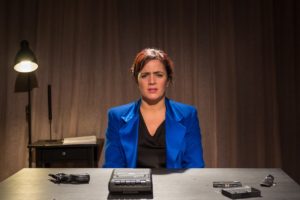

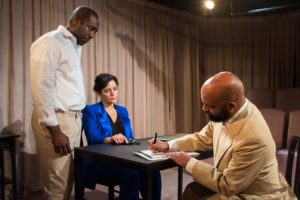
Death and the Maiden – Performance History
The play was given a first reading at the Institute of Contemporary Arts in The Mall in Central London on 30 November 1990. It had its world premier at the Royal Court Theatre Upstairs, (now the Jerwood Theatre Upstairs) on 4 July 1991 and, due to its immediate success transferred to the Main House on 31 October of that year.
The original cast were Juliet Stevenson in the role of Paulina, Bill Paterson as Geraldo and Michael Byrne as Roberto. Directed by Lindsay Posner the play transferred to the Duke of Yorks Theatre in the West End on 11 February 1992, with two cast changes. Geraldine James now played Paulina and Paul Freeman as Geraldo.
It was at this venue in late February 1992, that I saw this production. Twenty-five years on, it is still fresh in my memory, whereas nearly all other productions that I watched around this time, have been forgotten about, lost in the mists of time. I recall it because I had never seen a play of such ferocious intensity and I have rarely seen another since then.
The Playwright

Ariel Dorfman was born seventy five years ago in Buenos Aires in Argentina. The family moved to Chile via the USA, and he attended the University of Chile and later became a professor at that institution. He became a Chilean citizen in 1967.
From 1970 to 1973, Ariel Dorfman was employed as cultural advisor to Chilean President Salvador Allende and he was due to be on duty, (but had swapped his shift with a friend}, the night of the Pinochet Coup. Known as Chile’s 9/11, September 11 doesn’t only have tragic connections to the United States. Ariel was forced into exile and his works are known largely for their themes of tyranny and living in exile.
Ariel Dorfmann, since 1985 has been professor of literature and Latin American subjects at Duke University. He additionally holds American citizenship. His literature and work has given him the reputation of a defender of human rights.
The Play
In its ninety five minutes running time, Death and the Maiden introduces a myriad of important themes within a short period of time. It was awarded the 1992 Laurence Olivier Award for Best New Play,
Although the country is unnamed, it is clearly seen to represent the period immediately after the end of General Pinochet’s, (Margaret Thatcher’s great friend), dictatorship. It expresses the difficulties facing a nation emerging out of a dark period of totalitarianism into the clearer skies of democracy.
Prior to returning to the UK last year, I had been residing for a long time in China. Many of the students that I taught related stores about their own families, usually their grandparents who lived through the Cultural Revolution. Difficulties such as having to come to terms with your neighbours who before might well have denounced you as not being a good Chinese person in the image of Mao’s China at that time. So the issues are similar, but in this case, it was a case of one totalitarian system replaced by another. So I feel that this idea can work in many way. In the USA of President Trump’s presidency, it appears that the country is becoming increasingly divided over many issues. If this goes unchecked, then Post-Trump it could well lead to the situation found after Pinochet’s Chile, Mao’s China or a host of other places around the world today.
Incidentally, post 9/11, (American 9/11 that is), remember that torture of detained people suspected of terrorist links was legally justifiable by the overriding factor that it was carried out for the defence of that country.
The single theme that I would like to present concerns the battle between Justice on the one hand and Peace on the other. After years of authoritarian government, it is an inconvenient fact of life that many of the perpetrators of the previous regime still hold high position in government, finance and public affairs. Getting the balance, as represented by Geraldo in Death and the Maiden is an extremely challenging undertaking. As Paulina didn’t die in captivity, she cannot be investigated by the Commission, so is therefore devoid of any feeling of justification, or possibly revenge. This goes a long way in understanding her actions in the play. Her dilemma, and also the audience, is whether she should follow the weaker and compromised legal form of judicial enquiry, or to take more extreme measure to deliver a punishment that fits the crime.
By coincidence, on the very same day that I watched this production, President Trump (and arguably at a time when judicial justice could be irreparably dmagaed by his timing), stated that the alleged New York terrorist who drove a truck into people on the 1st November 2017, deserved the death penalty. There is a line in Death and the Maiden, “Some people don’t deserve to live”. Where have I heard that before recently?
This is by no means the only theme in the play. The inclusion of Schubert’s “Death and the Maiden” , (String Quartet No. 14) which represent High Art as degraded by the association in Paulina’s mind of her tortuous and humiliating experience is another.
In the end, nothing is resolved. The open ending which in my mind is the perfect one, is in place for you to consider the themes brought out in the play. Do we believe Paulina or Roberto? The role of Geraldo, who is disloyal to his wife, as mirrored by an earlier case of adultery, in an attempt to try and save Roberto’s life. There is plenty to think about.
Summary
Death and the Maiden is a wonderful play, which I hope convinces you that it is as important now as it was when written over twenty five years ago. Fio provide a solid production which is sufficiently good enough to do this difficult play justice. The play never has a dull moment and is pacey and enthralling. If you like serious drama which provides much to consider about what is going on in the world today, then I can unreservedly recommend this production at a great pub theatre venue.
http://www.otherroomtheatre.com/en/whats-on/current-productions/

Roger Barrington
 (4 / 5)
(4 / 5)
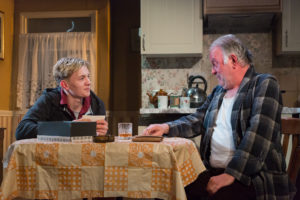

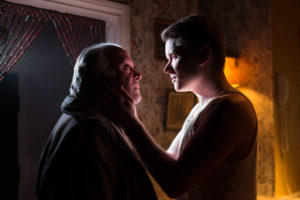

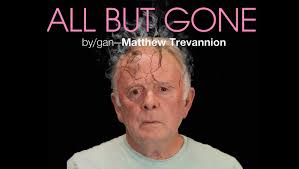

 (3 / 5)
(3 / 5)

